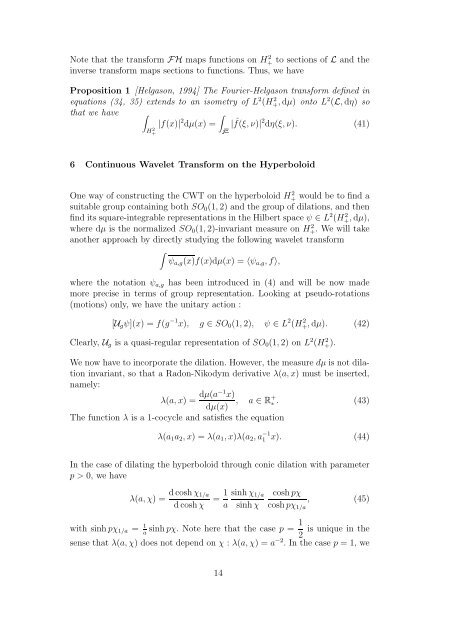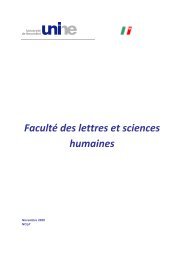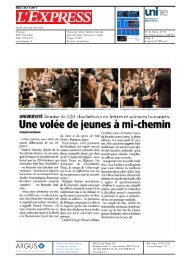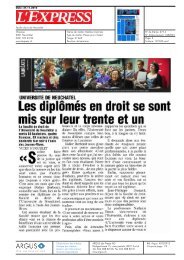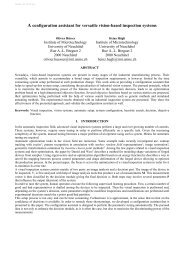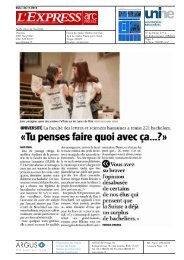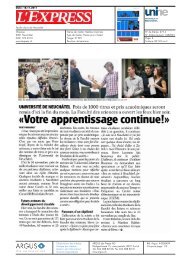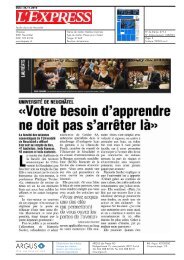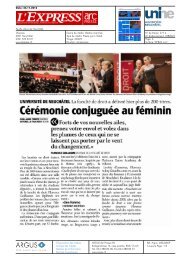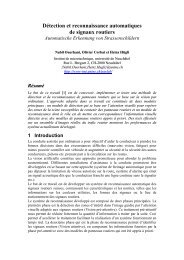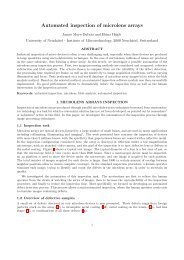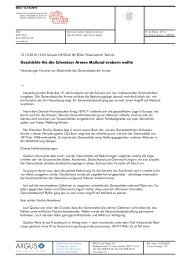Continuous Wavelet Transform on the Hyperboloid - Université de ...
Continuous Wavelet Transform on the Hyperboloid - Université de ...
Continuous Wavelet Transform on the Hyperboloid - Université de ...
You also want an ePaper? Increase the reach of your titles
YUMPU automatically turns print PDFs into web optimized ePapers that Google loves.
Note that <strong>the</strong> transform FH maps functi<strong>on</strong>s <strong>on</strong> H+ 2 to secti<strong>on</strong>s of L and <strong>the</strong><br />
inverse transform maps secti<strong>on</strong>s to functi<strong>on</strong>s. Thus, we have<br />
Propositi<strong>on</strong> 1 [Helgas<strong>on</strong>, 1994] The Fourier-Helgas<strong>on</strong> transform <strong>de</strong>fined in<br />
equati<strong>on</strong>s (34, 35) extends to an isometry of L 2 (H+, 2 dµ) <strong>on</strong>to L 2 (L, dη) so<br />
that we have ∫<br />
∫<br />
|f(x)| 2 dµ(x) = | ˆf(ξ,ν)| 2 dη(ξ,ν). (41)<br />
H 2 +<br />
jΞ<br />
6 <str<strong>on</strong>g>C<strong>on</strong>tinuous</str<strong>on</strong>g> <str<strong>on</strong>g>Wavelet</str<strong>on</strong>g> <str<strong>on</strong>g>Transform</str<strong>on</strong>g> <strong>on</strong> <strong>the</strong> <strong>Hyperboloid</strong><br />
One way of c<strong>on</strong>structing <strong>the</strong> CWT <strong>on</strong> <strong>the</strong> hyperboloid H 2 + would be to find a<br />
suitable group c<strong>on</strong>taining both SO 0 (1, 2) and <strong>the</strong> group of dilati<strong>on</strong>s, and <strong>the</strong>n<br />
find its square-integrable representati<strong>on</strong>s in <strong>the</strong> Hilbert space ψ ∈ L 2 (H 2 + , dµ),<br />
where dµ is <strong>the</strong> normalized SO 0 (1, 2)-invariant measure <strong>on</strong> H 2 +. We will take<br />
ano<strong>the</strong>r approach by directly studying <strong>the</strong> following wavelet transform<br />
∫<br />
ψ a,g (x)f(x)dµ(x) =〈ψ a,g ,f〉,<br />
where <strong>the</strong> notati<strong>on</strong> ψ a,g has been introduced in (4) and will be now ma<strong>de</strong><br />
more precise in terms of group representati<strong>on</strong>. Looking at pseudo-rotati<strong>on</strong>s<br />
(moti<strong>on</strong>s) <strong>on</strong>ly, we have <strong>the</strong> unitary acti<strong>on</strong> :<br />
[U g ψ](x) =f(g −1 x), g ∈ SO 0 (1, 2), ψ ∈ L 2 (H 2 +, dµ). (42)<br />
Clearly, U g is a quasi-regular representati<strong>on</strong> of SO 0 (1, 2) <strong>on</strong> L 2 (H 2 + ).<br />
We now have to incorporate <strong>the</strong> dilati<strong>on</strong>. However, <strong>the</strong> measure dµ is not dilati<strong>on</strong><br />
invariant, so that a Rad<strong>on</strong>-Nikodym <strong>de</strong>rivative λ(a, x) must be inserted,<br />
namely:<br />
λ(a, x) = dµ(a−1 x)<br />
, a ∈ R + ∗ . (43)<br />
dµ(x)<br />
The functi<strong>on</strong> λ is a 1-cocycle and satisfies <strong>the</strong> equati<strong>on</strong><br />
λ(a 1 a 2 ,x)=λ(a 1 ,x)λ(a 2 ,a −1<br />
1 x). (44)<br />
In <strong>the</strong> case of dilating <strong>the</strong> hyperboloid through c<strong>on</strong>ic dilati<strong>on</strong> with parameter<br />
p>0, we have<br />
λ(a, χ) = dcoshχ 1/a<br />
dcoshχ<br />
= 1 a<br />
sinh χ 1/a<br />
sinh χ<br />
cosh pχ<br />
cosh pχ 1/a<br />
, (45)<br />
with sinh pχ 1/a = 1 sinh pχ. Note here that <strong>the</strong> case p = 1 is unique in <strong>the</strong><br />
a<br />
2<br />
sense that λ(a, χ) does not <strong>de</strong>pend <strong>on</strong> χ : λ(a, χ) =a −2 .In<strong>the</strong>casep =1,we<br />
14


